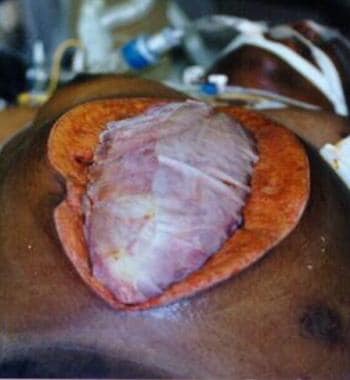Wittmann Patch Abdominal Closure

Wittmann Patch. The Wittmann Patch is a Velcro ®-like device for bridging and re-approximating abdominal wall openings where primary closure is not possible and/or repeat abdominal entries are necessary.
BACKGROUND: Abdominal compartment syndrome is frequently the result of aggressive fluid resuscitation after burn. Tafseer ibn kaseer online reading. Management of the open abdomen following decompressive celiotomy is a major problem. METHODS: From 2004 to mid-2005, six patients required decompressive celiotomy after developing abdominal compartment syndrome as a result of burn. A Wittmann Patch as used to close the abdominal wound. Patients were re-explored when clinical parameters improved and the abdomen was closed, with long-term follow-up for the abdominal wound. RESULTS: Of the six patients, five had thermal injury and one had electrical injury. The mean total body surface area affected for thermal burn was 78% and for electrical burn was 37%.

Diagnosis of abdominal compartment syndrome was based on elevated bladder pressure and organ dysfunction. The patients were treated with decompressive celiotomy and Wittmann Patch closure. Survivors subsequently underwent primary abdominal closure, with no evidence of ventral hernia at long-term follow-up. CONCLUSION: In burn cases with abdominal compartment syndrome, a Wittmann Patch ay prove a helpful method of temporary abdominal closure, followed by primary closure with no complications.
BACKGROUND: Although the 'open abdomen' has likely contributed to improved outcomes in trauma patients, the challenge of subsequent fascial closure has emerged. Since mid 2004, we have incorporated Wittmann Patch staged abdominal closure into our management of the open abdomen. The purpose of this study was to evaluate the impact of this device on our incidence of fascial closure versus planned ventral hernia.
METHODS: Patients managed by open abdomen from 2001 through 2006 were identified from the trauma registry. Fascial closure immediately after definitive repair of injuries was defined as 'early fascial closure.' Continuation of the open abdomen beyond the definitive repair of injuries with subsequent fascial closure was defined as 'delayed fascial closure.'
Since April 2004, the Wittmann Patch was uniformly employed in open abdomen management. Patients managed before the use of this device ('pre-Patch') were compared with those managed in the 'Patch' era. RESULTS: Fifty-six open abdomens were managed in the pre-Patch era and 103 were managed in the Patch era. In the pre-Patch era, 33 (59%) underwent early fascial closure, compared with 67 (65%) in the Patch era (p NS). For the remaining patients, the incidence of delayed fascial closure was significantly higher in those managed with the Wittmann Patch compared with those managed in the pre-Patch era (78% vs.